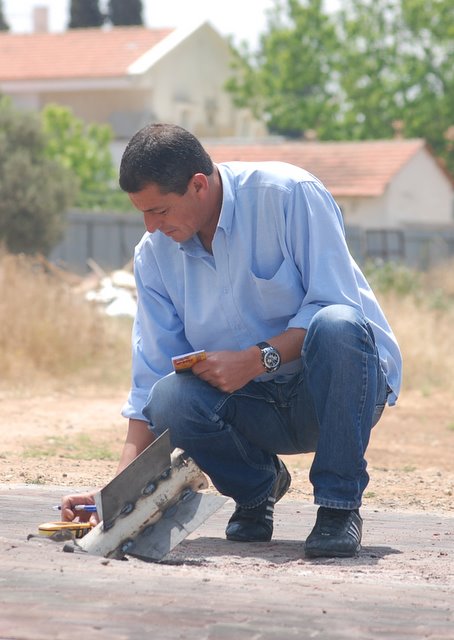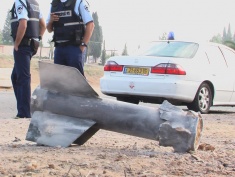Missile fire against Sderot and the western Negev began in January 2001. For the past 8 years, over 10,000 rockets have been launched towards Sderot and the western Negev. The Qassam rockets have claimed the lives of 28 Israelis; 9 of which were residents of Sderot, and 3 of whom were children. Rocket attacks have injured over 600 Israeli citizens and have psychologically traumatized thousands of Israeli civilians. The rockets have damaged countless homes and properties in Sderot and the western Negev.
Because Sderot lies 2.5 kilometers (about one mile) away from the Western Negev, the city bears most of the brunt from the rocket hits. Since Israel’s disengagement from the Gaza Strip in August 2005, Arab terrorists have increased the attacks, firing over 2,500 Qassam rockets. Sderot and the western Negev today experiences on average three Qassam rocket attacks per day
Palestinian rocket attacks have claimed the lives of 25 Israeli civilians, including 9 residents from Sderot, three of whom were children.
The Qassam rocket fire poses a major threat to Israel from Palestinian terrorist organizations who are based in Gaza. As of January 2008, over 10, 000 rockets have been launched at Sderot and the western Negev.
The Qassam Rocket

The Qassam, which can reach up to 20 km, is fueled by a mixture of potassium nitrate and sugar (solid propellant). Qassam missiles are manufactured and deployed primarily in the Gaza Strip; however, the IDF has seized Qassam missiles in Palestinian areas of the West Bank.
Due to the fact that the Qassam rocket is cheap, easy to manufacture, and simple to transport and operate, the rocket is used as the main weapon of terror against Israeli civilians by Palestinian terrorist operatives. Hamas and other terrorist organizations in the Gaza Strip use elementary technology to produce large quantities of rockets, which give them the ability to attack the Israeli populace in the western Negev at any time. Palestinian terrorists employ various methods including Google Earth, to fire Qassams towards civilian targets. The IDF cannot effectively respond to rocket launchers due to the fact that 97% rockets (according to the IDF) are fired from civilian populated areas in Gaza, often nearby schools, hospitals and mosques.
Different Models of the Qassam Rocket
|
Qassam-1 2001 |
Qassam-2 2002-2005 |
Qassam-3 Since 2005 |
|
|
Length (cm) |
80 |
180 |
200+ |
|
Diameter (mm) |
6 |
15 |
17 |
|
Weight (kg) |
5.5 |
32 |
90 |
|
Explosives Payload (kg) |
0.5 |
5-9 |
10-20 |
|
Max. Range (km) |
3–4.5 (1.8 mi +) |
8–9.5 |
10-20 |
Palestinian Terror Networks
Fatah’s Al-Aqsa Brigades: An armed military wing of Palestinian President Mahmoud Abbas’s Fatah party, the Al-Aqsa Martyrs Brigade frequently carries out rocket launches against Israel. In February 2008, the terrorist faction carried out a bombing attack in Dimona, in southern Israel. The Al-Aqsa rockets are identified by their yellow coloring with Arabic writing. The U.S. State department identifies Al-Aqsa Martyr Brigades as a terrorist organization.
Islamic Jihad: Islamic Jihad is affiliated with the Egyptian Islamic Jihad and is believed to be funded by Hezbollah, Syria and Iran. The armed wing of Islamic Jihad, the Al-Quds brigade fires Al-Quds rockets at Sderot and the Western Negev on a frequent basis. The Al-Quds rockets are identified by their red and yellow coloring. Produces the Qassam rocket (models 1, 2, 3), and is named after the terrorist organization’s armed wing.
Hamas: Since Hamas’s takeover of Gaza in mid-June 2007 to December 2007, there have been 475 missiles and 635 mortar shells launched at Israeli cities. Hamas rockets are identified by their red and green coloring
Mortar Shells
Between 2001 and November 2007, more than 2,500 mortar shells were fired. Their short range made them effective before the disengagement, especially when they were aimed at the IDF forces which operated in the Gaza Strip and at the Israeli settlements there. In the absence of Israeli targets after the disengagement there was a sharp decrease in the number of rockets fired.
Since April 2007 the terrorist organizations have begun to make greater use of mortar shells, especially Hamas, which does not directly participate in rocket fire. In recent months the fire has been aimed at IDF forces operating in the Gaza Strip and along the security fence, at the crossings (especially Kerem Shalom) and at the Israeli communities close to the security fence, such as Netiv Ha’asara, Kibbutz Kerem Shalom and Kibbutz Nahal Oz. Mortar fire in 2008 claimed the lives of three Israeli civilians living on kibbutzim along the Gaza border.
Katuysha Rockets
Although more rare, Katuysha rockets are occasionally fired from Gaza. Because the Katuysha rocket is much more advanced both in distance and design, Katuyshas have reached heavily populated Israeli cities like Ashkelon. Three Iranian-produced, 122mm Grad Katuysha rockets launched from Gaza have landed in both industrial and populated areas of Ashkelon in January 2008.
Palestinian Terror Groups in Gaza
- Hamas
- Palestinian Islamic Jihad
- Al-Aqsa Martyr Brigades
- Popular Resistance Committee (PRC)
Impact of Rocket Fire on Israeli Cities: Sderot and the Western Negev
The Qassam rocket fire has had a terrible impact on the Western Negev region, especially on the city of Sderot. The city’s population once numbered 24, 000 people. Today the population has fallen to an estimated 19,000, as over 5,000 residents have left. The following areas listed below have been considerably impacted by Palestinian rocket fire.
SECURITY:
The Israeli government has installed a radar system or “red alert alarm” in an attempt to alert Israelis to possible shellings, though it does not sound on cold or rainy days when the radar cannot detect the rocket launches. In addition, the siren system cannot detect the launching of mortar shells. Once the rocket is launched from Gaza and the siren sounds, Sderot residents have 15 seconds to escape to a bomb shelter. In the year 2007 alone, 2000 Qassams were launched from Gaza to Sderot and the western Negev according to an IDF spokesman. Over 1, 200 Qassam rockets were fired upon Sderot in 2008, including over 200 rockets during the ceasefire between June-December 2008.
MENTAL HEALTH:
Approximately 3000 patient files have been opened in the Sderot Mental Health Center due to the rocket fire environment. In the year 2007 alone, 1,117 trauma victim files were opened, up significantly from 2006. Anxiety symptoms among children often include sleeping difficulties, nightmares, sweating, development regressions, wetting beds, and fear of the outside. There are only 4 psychologists on call in Sderot. Therefore, many Sderot trauma victims do not receive the proper, if any, psychological therapy and care.
The mental health of Sderot residents has severely deteriorated over the past seven years as each rocket attack results in psychological turmoil. Between 2007 and 2008, more than 1,600 instances of stress were reported. According to a NATAL study (Center for Victims of Terror and War) done in 2008, between 70% to 94% of Sderot children suffer from symptoms of PTSD while 28% of children actually have PTSD. Thirty percent of Sderot adults have been diagnosed with PTSD.
The NATAL study also showed that almost 50% of Sderot residents know someone who has been killed in a Palestinian rocket attack, while 65% personally know someone wounded in an attack. Over 90% of Sderot residents have experienced a Palestinian Qassam explosion at some point-whether it be in a neighborhood, home, school, business or other residential setting.
ECONOMY:
The state of Israel has ruled that Sderot is not a war-zone area and therefore businesses and buildings damaged by rockets do not receive immediate payments for damages, but retroactive payments only.
Real estate and small businesses have suffered most from the rocket fire. According to Yakov Levy, a Sderot realtor, prices of homes have fallen by 50%. Housing prices were nearly double in 2000 before the rocket fire began. Around 20-30 percent of businesses in Sderot and surrounding areas have shut down since the rocket terror. Sales at stores in general have dropped by nearly 50 percent. During the intense rocket fire of May 2007, 350 small businesses were forced to close down. In January 2008, Hollandia, a major international mattress factory, employing close to 100 local residents in and around Sderot, was on the verge of shutting down the factory in Sderot and relocating elsewhere due to the rocket situation and security risks.
EDUCATION
The education in Sderot has been severely affected by the rocket attacks. Only 4 schools in Sderot offer complete buffer protection for students from rocket attacks. About 60% of the schools in Sderot do not have complete protection or buffers for their classrooms. In the past year, 1,100 kids have switched to schools outside of Sderot. Children in Sderot suffer from severe hyperactivity and have difficulty focusing in class.
Grades on exams and tests have dropped, while aggressive behavior among students in class has increased. Only 56.5% of 12th grade students in Sderot received their matriculation certificates in 2001, as half the students failed. The constant state of stress and panic due to the rocket fire contributed to the failing grades.
The Increasing Threat
Approximately 45, 000 residents in the Western Negev, which include Sderot and other numerous kibbutzim and moshavim, have been living under daily rocket terror. The number of Israelis living under rocket threat has increased to 250,000, which was predicted by according to Internal Security Minister, Avi Dichter in December 2007. Heavily populated cities like Ashkelon, Netivot, Ofakim and the inland city of Kiryat Gat will all be subject to rocket attack, once Palestinian terror groups begin launching long-range Katuysha rockets. In November 2008, the port city of Ashdod, was connected to the rocket alert system already in use in Ashkelon. It is an acknowledgement that threats by Palestinian militants to bring Ashkelon within range are being taken seriously.










